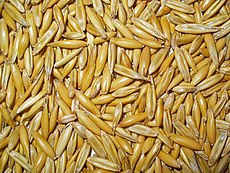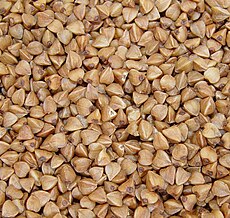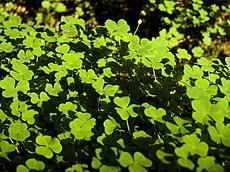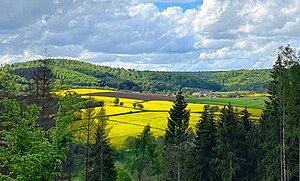Agriculture in Great Kirav

Agriculture in Great Kirav is a major economic activity underpinning local and regional economies across most of the island continent's land area.
As a result of its natural history, the agricultural endowment of the island continent includes both Old World and New World species, and has been supplemented by crops and animals introduced from other continents, such as wheat and cattle.
Even with modern improvements in agronomy, Mainland Kiravian agriculture is insufficiently productive to satisfy enormous domestic demand, and most of the island continent’s food supply is imported, mainly from Levantia, Sarpedon, and South Crona.
Agriculture in Æonara and in other parts of the Kiravian Federacy and Collectivity, such as Sydona, are covered separately.
Crops
Potato
To eat the potato now, or to ferment it for later? This is the perpetual dilemma of our People.
— Shafto, Analects of Shafto the Wise

The potato (Coscivian: ēln) is the most important food crop in Great Kirav, and has been since the dawn of agriculture. Potato began to be domesticated as early as 25,000 years ago in the central latitudes of the Western Highlands. The potato plant's remarkable ability to thrive in cool climates and subprime soil conditions made it indispensible to early Kiravian farmers and an enduring staple of the Kiravian diet. Indeed, the potato is credited with enabling sedentarisation of the proto-Coscivian tribes and, indirectly, the rise of Coscivian civilisation proper. Potato is grown throughout Great Kirav, but more so in the north and west. It is the dominant crop in the more marginal lands that make up much of the continent.
Potato planting season typically begins in early spring, depending on the temperature and soil conditions. Observance of the vernal equinox festival Élív includes traditions that celebrate a successful planting effort. Farmers prepare the soil by plowing, harrowing, and levelling it before planting the seed potatoes. The seed potatoes are placed in furrows, and then covered with a layer of soil. Manual cultivators accomplish this with the aid of a mattock. As the plants grow, they are hilled, meaning that more soil is piled around the base of the plant to support it and prevent the tubers from exposure to sunlight. This helps to prevent a green tinge that may affect the flavour and nutritional value of the potatoes. Most parts of Great Kirav regularly experience chilly and wet weather conditions, which can be challenging during the growing season. Frost poses a great danger to the crop in the critical periods just after planting and just before harvest. To protect the potato, farmers may install protective coverings, such as transparent films, over the fields. Harvest usually takes place in the autumn as the leaves start to turn yellow and die back. The potatoes are harvested with machines or by hand, then cleaned, graded, and sorted for distribution. After harvesting, the potato is stored in cool, dry conditions to preserve its quality. The harvest time is celebrated with festivals and fairs, where people can taste different varieties, buy fresh produce, and enjoy other cultural activities.
Potato is used in many dishes such as potato pancakes, potato soup, potato dumplings, and potato casseroles, and can also be milled into potato flour for baking. Beyond human consumption, the potato is also used to produce alcoholic spirits (thasstraśum) and industrial starches, and as fodder for pigs.
Cereals
 |
 |
 |
The principal grain crops grown in Great Kirav are the Three Reliables: Rye and wildrye, Coscivian cuckwheat, and oats, along with barley, wheat, and triticale.
Coscivian cultures conflate two distinct cereal grasses - Secale cereale or "true rye" and Elymus borealis or "wildrye" - under the label of "rye" (Kiravic: dralm, South Coscivian: drallion). Numerous cultivars of Elymus borealis have been cultivated in different regions and microclimatic zones of Great Kirav for centuries. True rye was most likely introduced from what is now Faneria during the Second Empire. Kiravian farmers were early adopters of triticale, production of which continues to expand in traditionally rye-growing areas. Indeed, it has been proposed numerous times that federal agriculture subsidies be amended to include cash incentives for rye farmers to transition to triticale instead, though such proposals have not yet been adopted.
The best farmland, much of which is concentrated in South Kirav and the warmer latitudes of the Baylands and Farravonia, is dedicated mainly to wheat, barley, and (increasingly) maize, as far as cereals are concerned. Hard red winter wheat is grown in drier mesotemperate areas of the interior, while durum wheat and other varieties are grown mainly in the South. Rye cum wildrye cultivation is well-established the upper supratemperate, hemiboreal, and boreal zones of Great Kirav, on account of the climatic conditions that make it difficult to grow other grains. "Rye" (sensu lato) and oats are resilient crops that tolerate lower temperatures and require shorter growing seasons than other grains, and thus can grow well in the harsh North Kiravian climate, with some especially hardy wildrye cultivars, such as Irovasdra alpine wildrye, being viable on a subsistence scale even at the highest arable altitudes and in the northernmost mesoboreal regions on the Coscivian Sea. Rye is often planted in the fall and harvested the following summer. Kiravian cereal farmers often practice crop rotation, where they alternate rye/wildrye with other crops such as barley, oats, or potatoes. This helps maintain healthy soil and prevents disease vectors and pest populations from building up. As a short-season crop that requires little in the way of fertilisers and pesticides, cuckwheat is often planted between primary rotations. In a few regions, such as southern Kannur, it can be planted as a double crop. Coscivian cuckwheat is also prized as a pollen source to support apiculture.
Root Vegetables
Hops
Hops are mainly grown in areas with an oceanic climate. Major hop-growing regions include the West Coast, South, and parts of the Eastern Highlands and Central Uplands. Kiravian hops supply the Kiravian brewing industry and are also exported.
Pre-mechanisation hop cultivation relied on a large seasonal labour force that migrated annually between hop-producing areas and areas of off-season employment. These workers came to regard themselves as distinct social groups known as the hop clans.
Fruit
Feed and Forage
 |
 |
 |
Oilcrops

Kiravia is a major producer of rapeseed, which by most measures is its most valuable non-food crop. In supratemperate or hemiboreal regions with oceanic or suboceanic climates, such as the maritime Northwest and certain parts of the Lake Belt, rapeseed is typically grown as a winter crop, sown in late summer or early autumn and harvested in late spring or early summer. However, it can also be cultivated as a spring crop, depending on the region and local weather conditions. The crop is typically sown by direct drilling or broadcasting, and requires regular fertilization and pest control. In supratemperate regions with a continental climate, rapeseed is typically grown as a spring crop, sown in early spring and harvested in late summer. The crop requires similar soil and climate conditions to those in oceanic regions, though farmers in continental climates are more reliant on conventional tillage methods and crop rotation to maintain soil fertility and improve crop yield.
Rapeseed oil has been used by Kiravians since time immemorial as a cooking oil, and was the predominant vegetable oil used in Kiravian cuisine before exposure to imported olive oil and other alternatives. In modern times, the oil is still in very high demand for a wide range of applications, most prominently for the production of biodiesel, as an ingredient in mass-produced margarine, mayonnaise, and other condiments, and for industrial use in paints, lubricants, and soaps. It is Great Kirav's most important agricultural export.
Other Crops
Other important agricultural products include:
- Allium: Onion, garlic, scallion, shallot, leek, and chives
- Starch crops: Mountain vine, Crisp potato, Kirish moss
- Thanksgiving shit: Pumpkins, gourds, squash
- Deez Nuts: Hazelnut, Shagnut, Chestnut
Stock

Kiravians rear animals for meat, milk, hide, horn, and other valuable products, such as insulin. Wool, from camelids and sheep alike, is a top agricultural export.
Many lowland pastoral regions of Great Kirav, such as Venèra and Axólega, are characterised by a bocage landscape in which parcels of land are separated by dense (and often very old) hedgerows and wooded berms to facilitate herd management and protect crop fields from grazing livestock. In other regions, such as Vôtaska and Elegia, silvopasture is the norm. Open rangeland grazing is most common in Korlēdan, Îkodha, Enscirya, and the South.
Also sheep.
Swine
Cattle
The first attempt to introduce cattle to inland Kirav was made in 25XD4+2Q CC by Oranibur Kaisthev, chancellor to the King of the Antarans. Kaisthev purchased some 400 head of Urcean longhorn cattle to increase the king’s revenues from montane pasturelands. However, upon their delivery to what is now County Upśur in Verakośa, the cattle were immediately slaughtered by terrified locals, who recognised them as the Devil’s hounds. Subsequent attempts were foiled along the same lines.
Korlēdan is the leading beef-producing state in Great Kirav. In recent years, beef enterprises in Korlēdan have been consolidating under a local affiliate of the Federation of Corummese Beef Producers.

Dogs
A pygmy dog breed known in Ænglish as the Kirish game hound is raised for meat, mainly in the interior and parts of the Baylands. Dogmeat was historically regarded as poor man's fare, but has recently undergone something of a lobster effect and become fashionable among the élite. Consumption of dogmeat was on the decline for much of the modern era, but rapidly expanded during the latter half of the Kirosocialist period due to food scarcity caused by the command economy. As dogs were outside the scope of government planning and not regulated as livestock, they could be raised for sale on the black market without fear of criminal penalty. Contemporary production is mainly for the domestic market, due to low foreign demand and legal prohibitions in many countries.
Economics
Landholding, Enterprise Types, and Labour Relations
Policy
Like many temperate industrialised countries, the Kiravian Federacy generously subsidizes its agricultural sector. Federal subsidies to agriculture in Great Kirav (both the Federation and the South) and Æonara are consolidated under a series of Triennial Agriculture Acts and administered by the Agricultural Executive. The federal subsidy programme covers all of the major food staples and cash crops discussed at length in this article; additional subsidies are extended by provincial governments, and often cover smaller-volume crops, emerging products, and regional specialties with a more limited geographic footprint. In addition to protection of the domestic agricultural sector, the Triennial Agricultural Acts address adjacent policy concerns, such as erosion and runoff mitigation, biosecurity, and the preservation of agricultural heritage. The Agricultural Executive also administers the Agricultural Reform Fund, which disburses payments to large landowners dispossessed by the Kiravian Union.
Markets
Agricultural futures and options are traded on several domestic exchanges. Exchanges whose soft-commodity contracts specify delivery points in Great Kirav are as follows:
- Escarda Grand Exchange - Potato, rye, elymus, cuckwheat, oats, triticale, feed clover, canola, milk, lean hogs, frozen pork bellies, broiler chickens, beet sugar, maple sugar,
- Silverda Mercantile Exchange - Potato, hops, crisp potato, Kirish seamoss starch, mountain vine starch,
- Primóra House of Trade - Barley, hops, wheat, kalir
- Xéulev Hall of Onions - Onions, leeks, cuckwheat, poultry preparations
Exports
Agricultural exports from Great Kirav, whether to the Kiravian colonies or foreign nations, are dwarfed by the massive scale of its imports and consist mainly of nonfood products. Key agricultural exports include hops and other brewing factors, canola and canola oil, dairy products, wool, kalir, flax fibre, potato-derived industrial starches, treenuts and treenut oils, and soaking herbs.
Since the return of capitalism, there have been efforts by the government and agricultural coöperatives such as the Kiravian Dairy Board to promote agricultural exports to foreign markets.